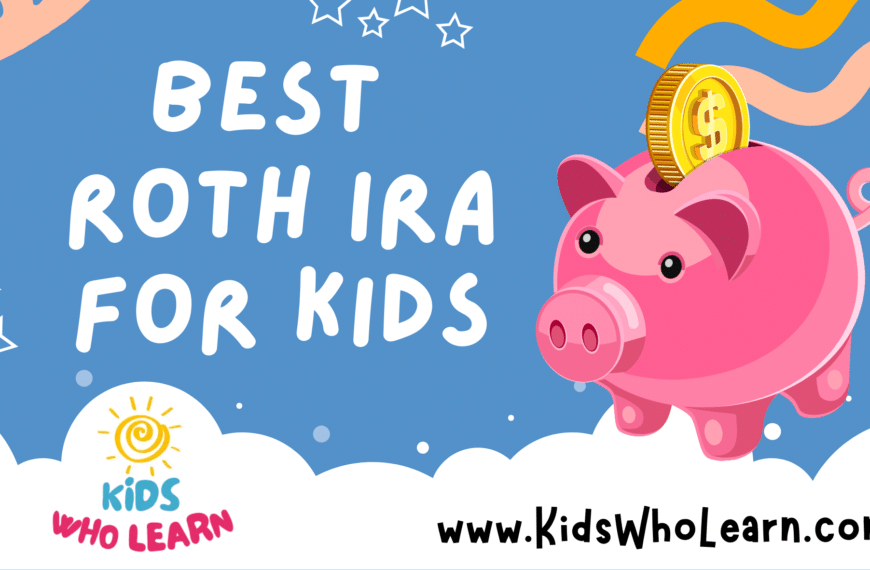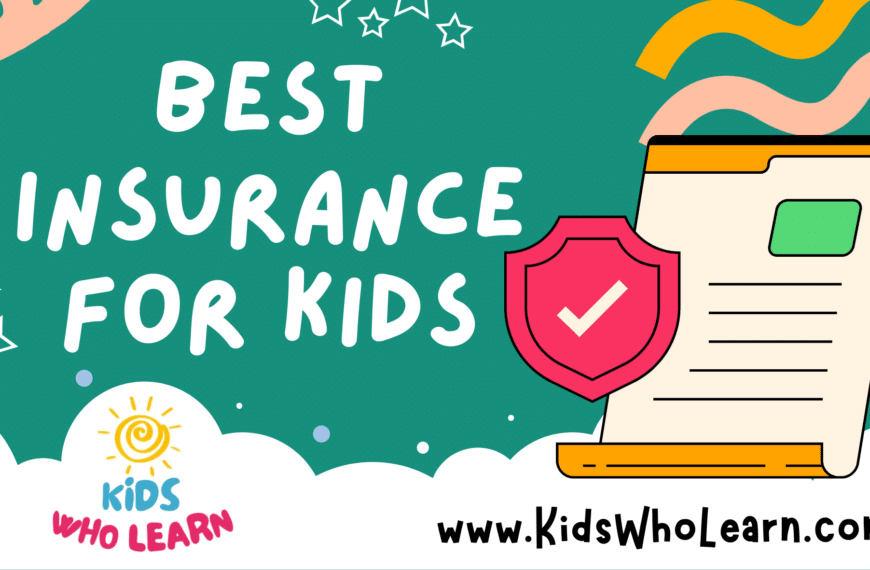Cultivating a culture of savings in children is not only beneficial for their future financial stability, but it’s also a valuable lesson in responsibility and monetary management. By initiating the conversation about savings early, kids can develop a solid understanding of the importance of financial security. There are various savings options tailored to the needs of children that can help jumpstart their journey toward economic awareness and independence.
Selecting the right savings account for your child is crucial, as different accounts offer unique features like interest rates, incentives, and terms that can either enhance or inhibit the growth of their savings. It’s important to choose an option that aligns with your financial goals for your child as well as one that allows for flexibility and accessibility. This will encourage your child to interact with their savings actively and understand the mechanics of account management.
Key Takeaways
- Establishing savings early primes children for future financial independence.
- Choosing an account should align with long-term goals and offer growth potential.
- Flexibility and accessibility in account management are key for children’s engagement.
Understanding Savings for Kids
When it comes to teaching your kids about money, savings accounts are a practical starting point. They offer a hands-on tool for children to learn financial literacy.
The Importance of Financial Literacy
By learning financial basics early, kids can develop sound money management skills. These skills prepare them for adult responsibilities like budgeting, saving for goals, and understanding the concept of money having value over time. Your involvement in teaching your child about savings accounts is crucial. It will not only introduce them to the concept of saving but also the discipline needed to make regular deposits and watch their money grow.
Savings Account Basics
A savings account for kids is specifically designed to be a simple, safe way for them to store their money in a bank.
Features of Kids Savings Accounts:
- Ownership: These accounts typically are held jointly with a parent or guardian.
- Interest: They earn interest over time, allowing your kids to see the benefits of saving.
- Minimum Balance: Most kids savings accounts have low or no minimum balance requirements.
- Fees: They often come with no monthly fees, making them cost-effective.
- Education: Banks may offer educational materials to complement the account.
| Account Feature | Description |
|---|---|
| Joint Ownership | A parent or guardian is usually required to co-own with the child. |
| Interest Rates | Competitive rates to encourage saving. |
| Minimum Balance | Typically low to make it easy to keep the account open. |
| Fees | Either very low or nonexistent to encourage use of the account. |
It’s your responsibility to help your child navigate their account. They’ll rely on you to understand how deposits work, how interest accumulates, and when they can withdraw funds. Starting this education early arms them with knowledge and habits that will serve them for a lifetime.
Choosing the Right Savings Accounts
When selecting a savings account for your child, consider the institution’s reputation, account features, interest rates, and fees. This will ensure that you’re choosing an option that will benefit your child’s financial future.
Evaluating Various Financial Institutions
Different financial institutions offer varied benefits and options for savings accounts for kids. You should assess each one based on their merits and suitability for your child’s needs.
- Banks: Traditional brick-and-mortar banks are known for their reliability and may offer the convenience of local branches. However, they might provide lower APY (Annual Percentage Yield) compared to online alternatives.
- Credit Unions: Credit unions often provide more competitive interest rates and lower fees than banks, but they may require membership based on certain criteria, such as your location or employer.
- Online Banks: They typically offer high-yield savings accounts with above-average interest rates and fewer fees. They may lack physical branches, which is a trade-off for the higher rates.
Table 1: Comparison of Savings Account Providers
| Institution Type | APY | Fees | Minimum Balance | Access |
|---|---|---|---|---|
| Brick-and-Mortar Banks | Lower | Potentially higher | May have | In-person/Online |
| Credit Unions | Competitive | Lower | Varies | In-person/Online/Membership required |
| Online Banks | Higher | Lower | Often none | Online only |
Make sure to check if the institution is a Member FDIC or part of a similar network to ensure the safety and insurance of the deposits.
Features of the Best Savings Accounts for Kids
The best savings accounts for children blend excellent financial education with growth potential. Here’s what to look for:
- Interest Rates: Aim for accounts with competitive or above-average interest rates, like those offered by Alliant Credit Union and Spectrum Credit Union, to maximize your child’s savings growth.
- Fees: Opt for accounts with minimal or no fees to ensure that charges don’t eat into your child’s savings. Many accounts aimed at kids, such as Capital One Kids Savings Account, are designed to be fee-friendly.
- Minimum Balance and Deposits: Accounts that require no minimum balance or deposit, like the Alliant Credit Union Kids Savings Account, are ideal, as they allow for flexible savings habits regardless of the amount your child has to save.
- Accessibility and Education: It’s important the account provides easy access and tools to help your child learn about managing money. Online banks often excel at this, providing digital platforms for tracking savings and learning about banking.
By reviewing these factors, you can set up a savings account for your child that encourages sound financial habits and capitalizes on earning potential.
Account Management and Accessibility
Effective account management and accessibility involve understanding the integration of digital platforms and the convenience of physical banking tools such as ATMs and debit cards. Strategic use of these services can significantly enhance your child or teen’s banking experience, teaching them both fiscal responsibility and technological proficiency.
Understanding Digital and Mobile Banking
When you open a Youth Checking Account or a MyLife Checking for Teens with Bethpage Federal Credit Union, you’re providing your child with a solid foundation for digital banking. The mobile app that accompanies these accounts allows for 24/7 account monitoring, ensuring that both you and your teen can track spending and savings with ease. It’s essential that you:
- Educate your child on how to use the mobile banking app for activities such as checking balances and transferring money.
- Set up alerts for transactions, which can help you and your teen stay on top of the account activity.
Additionally, digital banking often includes features like online bill pay and depositing checks through the app, capacities that introduce your teen to adult financial responsibilities.
ATM Access and Membership Benefits
With a debit card linked to the checking account, your child gains access to Bethpage Federal Credit Union’s network of ATMs. For young account holders, knowing how to:
- Utilize an ATM for deposits and withdrawals is a key aspect of account accessibility.
- Understand the limits and potential fees associated with ATM use is crucial for financial management.
Membership benefits often include fee-free ATM transactions within the credit union’s network and potential reimbursement for fees charged by out-of-network ATMs. This makes it convenient and cost-effective for your teen to access their funds when they need it.
Incentives and Growth Potential
Your children’s savings can significantly benefit from the right mix of incentives and growth opportunities. These factors play a crucial role in building a robust financial foundation for the future.
Interest Earning and Compound Interest
When you open a savings account for your child, one of the key features to look for is the interest rate. An account with a competitive rate can help the savings balance grow over time. Compound interest, in particular, is a powerful mechanism where interest is earned on both the initial deposit and the accumulated interest from previous periods. For example, if an account offers an annual percentage yield (APY) of 2%, for an initial $1,000 deposit, here’s how the balance could grow over five years:
| Year | Balance |
|---|---|
| 1 | $1,020.00 |
| 2 | $1,040.40 |
| 3 | $1,061.21 |
| 4 | $1,082.43 |
| 5 | $1,104.08 |
This table assumes the interest compounds annually and that there are no additional deposits or withdrawals.
Bonuses and Rewards for Kids
Many financial institutions offer bonuses and rewards as incentives for children to save more. These can come in various forms, such as a birthday bonus where the bank adds a certain amount to the savings account as a gift. Other bonuses may include:
- Match on Initial Deposit: Some banks will match a percentage of the first deposit made into a new child’s savings account.
- Regular Deposit Bonuses: A small reward could be given for each deposit made, encouraging regular saving habits.
For instance, if your child receives a $10 birthday gift from the bank each year, this would further increase the savings balance, not to mention the additional compound interest generated by the extra amount. Always read the fine print to understand the conditions and eligibility for these incentives.
Additional Financial Products for Kids
When it comes to managing money, kids’ savings accounts are just the beginning. There is a variety of financial products aimed at helping children and teens understand money better, save effectively, and even begin investing for their future needs.
Exploring Checking Accounts for Teens
Checking accounts designed for teens can serve as powerful tools for financial education and independence. USAlliance Financial’s MyLife Checking for Teens is a prime example, providing a safe environment for older kids to learn money management under parental supervision. Such accounts usually come with features like:
- No monthly maintenance fees: Encouraging regular account use without the worry of incurring costs.
- Debit cards with set limits: Allowing teens to make purchases while controlling their spending.
Investment Opportunities and Education Savings
Investing can open the door to long-term savings goals for your child. As early as childhood, consider setting up an Education Savings Account (ESA) or a custodial account where you can invest in stocks, bonds, or mutual funds on behalf of your child.
- USAlliance Financial’s MyLife Savings for Kids: Serves as a starter savings account with a competitive interest rate to help kickstart your child’s savings.
- Education Savings Accounts (ESAs): Help set aside funds for education-related expenses, allowing the investment to grow tax-free until it’s needed for school.
By involving kids in investment choices, you not only help them save but also provide invaluable lessons in financial planning and the power of compound interest. Remember to set clear financial goals with your child, fostering a sense of commitment and understanding toward their personal savings journey.
Practical Considerations
When selecting a savings account for your child, it’s crucial to comprehend the specifics of account management and the associated costs. These details can impact how you save and the growth potential of your child’s funds.
Account Opening and Maintenance Requirements
To open a savings account for your child, you’ll typically need to make an initial deposit. This amount can vary widely by institution, ranging from a nominal $5 to over $100.
- Initial Deposit: $5 – $100+
- Balance Requirement: Minimums can apply
Furthermore, maintaining the account might come with additional requirements. Some banks have a stipulated minimum balance requirement to avoid maintenance fees.
- Monthly Fee: $0 – $10 (may vary)
- Maintenance Fees: Waived if balance requirements are met
Understanding Fees and Costs
Managing money in a savings account incurs certain fees and costs that you must be aware of. These can take a form of a monthly fee, which some banks waive if you maintain a specific balance. It’s important to know what fees you may encounter and how to avoid them.
- Monthly Fee: Typically waived with minimum balance
- Balance Requirement: Keeping a set amount to avoid costs
Here’s a simple table summarizing typical fees and how to potentially avoid them:
| Fee Type | Typical Cost | How to Avoid |
|---|---|---|
| Opening Deposit | $5 – $100+ | Varies by bank |
| Monthly Fee | $0 – $10 | Maintain minimum balance |
| Maintenance Fees | Varies | Meet bank’s balance requirement |
Keep in mind that understanding these fees and requirements is essential for effective management of your child’s savings account.
Unique Accounts and Programs
When it comes to savings for kids, specialized accounts and partnerships offer tailored solutions for different life stages and goals.
Specialized Savings Accounts for Unique Situations
Northpointe Bank Kids Savings Account: This is a tool designed for minors to begin saving early. The account features a competitive interest rate to help achieve financial goals. With a teen checking account option, Northpointe Bank provides an opportunity for older children to manage their money with adult supervision.
Step: A banking platform offering a teen checking account tied to a secure app encourages responsible spending and saving practices. Step allows for easy tracking of financial goals and fosters financial literacy from an early age.
Partnerships with Educational and Nonprofit Organizations
Credit Union Membership: Many credit unions provide youth accounts with benefits such as lower fees and educational resources. Membership requirements vary, but they generally promote financial education for young members.
- Capital One 360: Offers kid-friendly savings accounts with no monthly fees. This program aligns with nonprofit organizations to provide financial education, such as the collaboration with Sesame Street on money management concepts.
- Foster Care to Success: This nonprofit organization partners with financial institutions to assist youth in foster care. It provides resources to help them manage their finances and prepare for adulthood.
Remember that when exploring these options, each program has its unique features and benefits, so it’s important to choose the one that best fits your needs and financial situation.
Creating a Savings Plan
Crafting a savings plan for your child sets the foundation for financial responsibility and literacy. This plan focuses on establishing attainable goals and fostering consistent saving behaviors.
Setting and Achieving Savings Milestones
To start, identify clear savings goals that are both achievable and motivating for your child. For example, you might set a goal of saving $50 from their allowance to purchase a new toy. Utilize a simple table to track these milestones:
| Milestone | Goal Amount | Estimated Timeframe | Reward |
|---|---|---|---|
| First Savings | $50 | 2 months | New Toy |
| Mid-Term Savings | $100 | 6 months | Visit to a theme park |
| Long-Term Savings | $200 | 1 year | New Bicycle |
Encourage regular deposits by matching a percentage of their allowance for every dollar saved, reinforcing the benefits of saving over spending.
Inculcating Saving Habits from an Early Age
Establishing saving habits early on is crucial. Introduce a weekly savings routine where you sit down with your child and discuss their savings progress. Use educational resources to illustrate how savings accumulate over time, such as age-appropriate books or financial literacy games.
By aligning saving habits with regular activities, like receiving an allowance, you can help your child understand the value of money and financial planning. Remember, consistency is key in developing lifelong financial habits.
Legal and Tax Considerations
When opening savings accounts for children, understanding the legal and tax responsibilities is crucial. Specifically, as a custodian, you have to consider the implications of custodial accounts and how taxes will affect any interest earned.
Custodial Accounts and Their Implications
Custodial accounts, such as UGMA or UTMA, allow you to save money for a child with certain legal restrictions. You, as the custodian, are responsible for managing the money until the child reaches the age where they gain control (age of majority).
- Age of Majority: Varies by state, typically 18 or 21.
- Control: Upon reaching the age, funds transfer to the child for their use.
Tax Impact on Interest Earned
The interest earned on savings accounts for children is subject to taxes. The tax rate and implications can vary depending on the amount of interest earned and the account type.
- Annual Percentage Yield (APY): Reflects the real rate of return on the interest.
- Interest Rates: The rate at which the account accrues interest.
Taxed Interest:
- First $1,100 of earned interest: Typically not taxed.
- Next $1,100: Taxed at the child’s tax rate.
- Beyond $2,200: Taxed at the custodian’s or parent’s tax rate.
Remember to consult a tax advisor for your specific situation to ensure compliance and maximize savings benefits.
Expert Opinions and Reviews
Your understanding of the best savings options for kids can be significantly enhanced by expert analyses and authoritative insights in the field of personal finance.
Analysis and Methodology
Experts employ a structured methodology to evaluate savings accounts for kids, often considering factors such as interest rates, minimum balance requirements, fees, accessibility, and educational resources provided by the financial institution. A comprehensive analysis might include a comparison chart detailing these factors across different savings options.
- Interest Rates: A crucial aspect, as higher rates can greatly increase the savings over time.
- Minimum Balance: Some accounts may require a minimum balance, which can affect accessibility for all families.
- Fees: An account with no monthly fees helps maximize savings.
- Access & Control: Experts review who controls the account (the child or the parent) and how funds can be accessed.
- Educational Resources: Additional resources provided by banks to educate kids about personal finance can be a valuable feature.
Insights from Personal Finance Authorities
Personal finance authorities share their insights, often agreeing that early financial education using children-centric savings accounts is key to fostering financial literacy. Authorities like certified financial planners and personal finance authors might recommend accounts that come with tools to teach kids about money.
- Credit Cards: Some experts bring attention on the potential of secured credit cards for older children as a teaching tool for credit use and management.
- Financial Habits: The importance of developing smart saving and spending habits at an early age is a common topic.
The author’s expertise is given weight if they have a track record of insightful contributions to the field of personal finance, especially regarding savings and financial education for young audiences. Their opinions become a trusted resource to navigate the myriad of options available.
Conclusion
When selecting the best savings options for your children, consider the following key points:
- Flexibility: Choose accounts that offer flexible access to funds.
- Interest Rates: Look for competitive interest rates to maximize growth.
- Tax Advantages: Take advantage of tax-efficient savings vehicles.
Remember to review the terms and conditions of any savings plan. It’s essential to assess how it aligns with your financial goals for your child’s future. Monitoring and adapting your savings strategy as your child grows will ensure that you are always aligned with the best options available.
Regular contributions, even if small, can compound over time and lead to significant savings. Engaging your children in discussions about saving and budgeting can also impart valuable financial literacy skills.
Lastly, consult with a financial advisor to tailor a savings plan that best suits your family’s needs. Your proactive steps today will pave the way for your child’s financial security tomorrow.
Frequently Asked Questions
Before choosing the best savings for your child, it’s important to understand each option’s benefits and suitability. Below are some specific, commonly asked questions to guide you in making informed decisions.
What are the most advantageous savings accounts for children?
The most advantageous savings accounts for children often include features like no monthly fees, competitive interest rates, and educational resources to help kids learn about money management. Look for accounts that are specifically designed for young savers.
Which banks offer the best interest rates for kids’ savings accounts?
Some banks offer higher interest rates for kids’ savings accounts to encourage early financial literacy and savings habits. These banks may also provide added perks like matching contributions to motivate regular saving.
What is the ideal type of investment account for a child’s future?
An ideal investment account for a child’s future often depends on the child’s age and the financial goal. Custodial brokerage accounts or individual retirement accounts (IRAs) for minors can be ideal for long-term growth, whereas a traditional savings account may be better for short-term goals.
How can parents open a savings account in their child’s name?
To open a savings account in their child’s name, parents typically need to provide the child’s Social Security number, birth certificate and other identification documents. Parents will often need to be listed as joint account holders.
Are 529 plans the optimal savings option for a child’s education expenses?
529 plans are often considered optimal for saving for a child’s education due to their tax advantages and high contribution limits. They allow for tax-free growth and distributions when the funds are used for qualified education expenses.
Is a Certificate of Deposit (CD) suitable for long-term savings for a child?
A Certificate of Deposit (CD) may be a suitable option for long-term savings, as they traditionally offer higher interest rates than savings accounts, in exchange for locking in the deposit for a set term. CDs can be a good choice if you won’t need immediate access to the funds.














